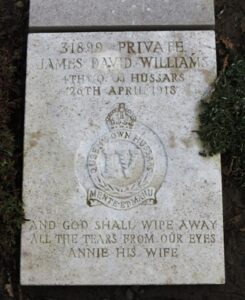Borth is situated seven miles north of Aberystwyth, on the estuary of the River Dyfi, overlooking Cardigan Bay. The village was once a thriving fishing port, but is now better known as a popular holiday destination. The village is served by the St. Matthew’s Church, inside of which is a marble war memorial to its parishioners who fell during the Great War. This page commemorates the men on the St. Matthews’s Great War Memorial. There are also war memorials inside the Church which were erected there after the closure of Gerlan Methodist Church on 25 March 2013. These memorials were from Gerlan, Shiloh and Soar Chapels, and are on their own pages on this website.
The Great War, 1914-1918
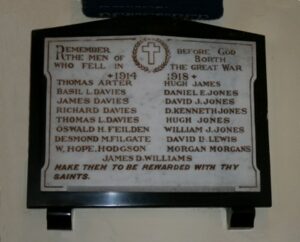
Thomas Arter, First Engineer, Mercantile Marine. Thomas was born in 1880, the son of John and Ann Arter, of Bay View, Borth. He served with the Mercantile Marine aboard the SS Harbury. Harbury was a defensively-armed merchant steamer. On Saturday 9 June 1917, she was 170 miles from Ushant, when she was torpedoed without warning and sunk by a German submarine. Thomas was among 12 men lost in the sinking that day. He was 36 years old, and is commemorated on the Tower Hill Memorial, London.
Prosper Charles Colman, Fireman, Mercantile Marine. Prosper was born in Belgium in 1891 and was the husband of Poldine Colman, of 37, Kluis Street, Antwerp. He served with the Mercantile Marine aboard the SS Memphian, a Liverpool registered steamer. On 8 October 1917, Memphian was on voyage from Liverpool to New Orleans, when she was torpedoed and sunk by the German submarine U-96, 7 miles from the North Arklow lightvessel. Thirty-two men were lost in the sinking, including Prosper, who was 26 years old. Some weeks after the sinking, bodies of some of the sailors washed ashore at various locations along the Welsh coast. Prosper’s body was recovered along with two others and buried in St. Matthew’s Churchyard at Borth as Unknown Sailors. Within recent years, Prosper’s grave was identified and a new CWGC headstone was erected. Although buried in the Churchyard, Prosper is obviously not commemorated on the war memorial.
Basil Lougher Davies, Sailor, Mercantile Marine. Basil was born in 1897, the son of Thomas and Mary Anne Davies, of Gloucester House, Borth. He served with the Mercantile Marine aboard the SS Penvearn. On 1 March 1918, she was 15 miles from South Stack, Anglesey, when she was torpedoed and sank by the German submarine UB-48. Basil was among the men lost in the sinking that day. He was 20 years old, and is commemorated on the Tower Hill Memorial, London.
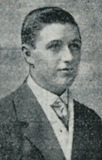
James Davies. James lived at Wesleyan Place, Borth, and had been discharged from the Royal Navy after losing an eye early in the war. On 23 November 1917 he set out from Borth Bay aboard a small boat with his nephew, Richard Davies and 13 year old Henry Jones, aiming to carry out some fishing, and also to salvage some floating debris, possibly cork, which they had seen floating in the bay. Nothing more was heard of them, so the lifeboat was launched at 05.00 pm, but no trace of the three was found. Their boat drifted ashore at Aberdovey bar later that day. James was 50 years old, and because he is not a war casualty, is not commemorated by the CWGC.
Richard Davies, Deck Hand, DA/9/88, Royal Naval Reserve. Richard was born at Borth on 29 December 1863, and married in 1878, residing with his wife, Mary Davies, and their children at 5, Wesleyan Place, Borth. Richard worked as a labourer prior to the war, but was also a Royal Naval Reservist. He was recalled to the colours at the outbreak of war, and was posted to HM Trawler Evangel. She was used for anti-submarine duties in the Irish Sea, sailing from her base at Milford Haven. On 25 March 1917, Evangel was on patrol off Milford when she struck a mine which had been laid by the German submarine UC-48, and sank with the loss of 25 lives. Richard was among the men killed that day, and was 54 years old. His body was recovered from the sea, and he was buried at Penygarn Calvinistic Methodist Cemetery, Tirymynach.
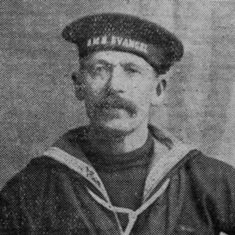
Thomas Lewis Davies, Private, 26752, South Wales Borderers. Thomas was born at Borth in 1895, the son of Thomas and Mary Davies, of Nathaniel House, Borth. He originally enlisted into the Royal Flying Corps, but at sometime after 1915 transferred into the 7th Battalion, South Wales Borderers, which was attached to 67 Brigade, 22nd Division. Thomas joined the battalion at Salonika sometime in 1916. Between 10 to 18 August 1916 they fought at the battle of Horseshoe Hill, then between 13 to 14 September 1916 at the battle of Machukovo. Between 24-25 April and 8-9 May 1917 the Division fought at the battle of Doiran, and then on 18 September 1918 at the Second Battle of Doiran. Thomas was killed in action here, at the Second Battle of Doiran, on 18 September 1918. He was 23 years old, and is buried at Doiran Military Cemetery, Salonika.
Oswald Henry Feilden, Captain, Leicestershire Regiment. Oswald was born at Borth in 1887 the son of Lt.-Col. Robert and Emily Jane Feilden, of 1, Cambrian Terrace. His parents later resided at Lane End, Hartney, Spilsby, Lincs. Oswald had been educated at Llandovery College from 1898 to 1900, before taking his degree at Aberystwyth. Oswald joined the Leicestershire Territorial’s in 1911, and was commissioned into the 5th Battalion, Leicestershire Regiment on 15 January 1912. The Division had served in Ireland and had been involved in the Easter uprising, before being sent to the Western Front, where they landed in France on 24 February 1917, attached to 177 Brigade, 59th Division. They fought during the German retreat to the Hindenburg Line, and then moved to Ypres. After training around the Vormezeele area in Flanders in early September 1917, Oswald’s Battalion moved to St. Jean near Ypres, to prepare for a major attack which was timed to take place on 26 September. At 05.50 hours on 26 September 1917, the 2/5th Leicester’s, attacked hill 37, taking all its objectives. Oswald was severely wounded in this action and died from his wounds at 46 Casualty Clearing Station, Proven on 29 September 1917, aged 30. Oswald is buried there, at Mendinghem Military Cemetery, Belgium.
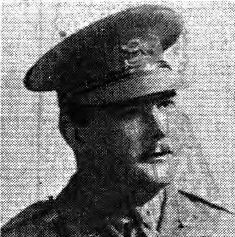
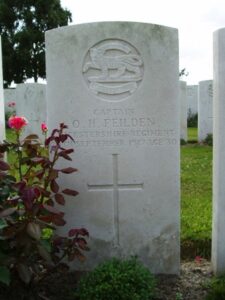
Robert Humphrey Feilden, MC, Major, Royal Field Artillery. Robert was born on 11 October 1884, the son of Robert and Emily Jane Feilden, of Thorner, near Leeds. By 1891 the family was residing at Cambrian Terrace, Henllys. Robert emigrated to Canada in 1914, but returned to Britain after the outbreak of war, and serving as a Second Lieutenant with the Special Reserve, Royal Field Artillery, was promoted Lieutenant on 25 August 1914, and posted to France, landing on 19 December 1914. Robert married Olive Binyon whilst on leave in 1915, and was promoted Captain on 17 November 1915. On 25 November 1916 Robert was promoted to Temporary Major, whilst commanding his battery. His award of the Military Cross was published in the London Gazette of 28 December 1917, whilst he was serving as Acting Major. He looks to have transferred to the Royal Air Force towards the end of the war, and survived four years of conflict, before returning home to 46, Paulton Square, Chelsea. After the war, Robert went back to Canada with Olive in July 1920. Sadly, Robert accidentally drowned at Troutbeek, Mara, British Columbia on 17 July 1925. Olive returned to Britain in July 1928, and died in London in 1971. Robert is commemorated on an individual memorial inside the Church.
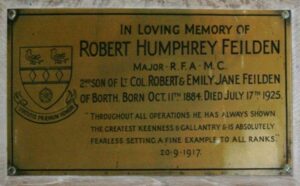
William Hope Hodgson, Lieutenant, Royal Field Artillery. William was born on 15 November 1877, the son of Reverend Samuel and Lissie S. Hodgson, of Lisswood, Borth. William became a well known photographer, poet and author prior to the war, after having spent many years at sea, providing for his family after the death of his father. He married Bessie Gertrude Farnworth at Kensington in 1913, and the couple resided at 14, Queens Road, Cheadle Hulme. After the outbreak of war, William was commissioned into the Royal Field Artillery, and landed in France on 5 October 1917, where he became attached to the 11th Army Brigade, Royal Field Artillery. William was listed as having died on 17 April 1918. He was 40 years old, and is commemorated on the Tyne Cot Memorial, Belgium. William was possibly acting as an aerial observer with the Royal Flying Corps when he died, working on artillery spotting.
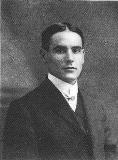
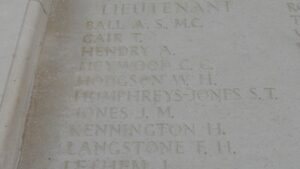
Hugh James, Boatswain (Bosun), Mercantile Marine. Hugh was born at sea in 1881, the son of Hugh and Margaret James, of Borth. He married Mary Jane Bywater, and the couple resided at Manchester House, Borth. Hugh served in the Mercantile Marine aboard the SS Penvearn, a Falmouth registered steamship. On 1 March 1918, Penvearn was 15 miles from South Stack, Anglesea, in ballast, when she was torpedoed and sank by the German submarine UB-48. Hugh was amongst 21 men who died in the sinking that day. He was 37 years old, and is commemorated on the Tower Hill Memorial, London.
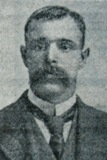
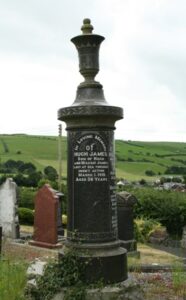
Daniel Evan Jones, First Engineer, Mercantile Marine. Daniel was born in 1886, the son of Jenkin and Margaret Jones, of Caradog, Borth. He served as an engineer in the Mercantile Marine aboard the SS Canganian, a Cardiff registered steamer. On 17 November 1916 she was on voyage from Methil to Scapa Flow when she struck a mine which had been laid by the German submarine UC-29, and sank with the loss of 13 lives. Daniel was 31 years old when he died that day, and is commemorated on the Tower Hill Memorial, London.
David John Jones, Private, 129150, Canadian Infantry. David was born on 9 August 1887, the son of William David Jones and Elizabeth Jones, of Bodfor House, Borth. David emigrated to Canada prior to the war, where he worked as a Carpenter. He enlisted at Vancouver on 11 September 1915 into the Canadian Infantry, and was posted to the 72nd Battalion, British Columbia Regiment, which was attached to the 4th Canadian Division, and crossed to France in August 1916 after forming in southern England. The Division moved to the Somme, and took part in the Somme Offensive, fighting at the Battle of Le Transloy, and the Battle of the Ancre Heights, where they captured Regina Trench. David was killed at Le Sars on 1 November 1916, while patrolling in No Mans Land, when his party was caught up in a bomb fight with some Germans. He was 29 years old, and is buried at Adanac Military Cemetery, Miraumont, France.
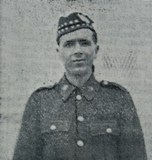
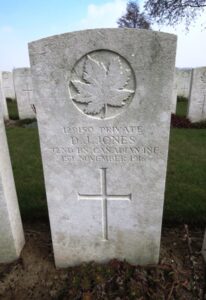
David Kenneth Jones, Able Seaman, Mercantile Marine. David was born in 1901, the son of Edward and Mary Jones, of Glanmor House, Borth. He served with the Mercantile Marine aboard the SS Heathpark, a steamship. On 5 October 1918, Heathpark was on voyage from Bilbao to Maryport with a cargo of ore, when she was sunk by the German submarine U-91 in the Bay of Biscay. David was among 15 men lost in the sinking. He was 16 years old, and is commemorated on the Tower Hill Memorial, London.
Hugh Jones, Master, Mercantile Marine. Hugh was the son of David and Ann Jones of Borth. He married Anne Jane Edwards at Hull in 1906, and the couple set up home at Surrey House, Borth. Hugh served with the Mercantile Marine as Master of the SS Heathpark. On 5 October 1918, Heathpark was torpedoed and sunk by the German submarine U-91 whilst in the Bay of Biscay. All her crew were lost at sea, but Hugh’s body was found by Spanish Fishermen, who brought him ashore at Bilbao, and buried him at Bilbao British Cemetery, Spain. Hugh was 44 years old.
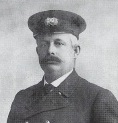
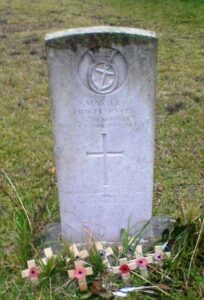
William John Jones, Driver, W/3765, Royal Field Artillery. William was born in 1892, the son of William and Jane Jones, of Bryn Y Mor, Borth. He lived at Gilfach Goch prior to the war, working as a bricklayer. William enlisted at Tonypandy on 23 April 1915 into the 38th (Welsh) Division Ammunition Column, Royal Field Artillery, and landed in France on 24 December 1915, joining up with the bulk of the 38th Division in the Fleurbaix sector. Very little is presently known of William, but he was discharged from the Royal Field Artillery on 11 December 1916 due to tuberculosis, and died at home in Craigfryn on 28 August 1917, aged 25. William’s case was passed onto the CWGC on 5 August 2012, and he was accepted for commemoration on Thursday 7 August 2014. He will be commemorated in the United Kingdom Book of Remembrance, although he appears to have been buried in Llandre on 1 September 1917.
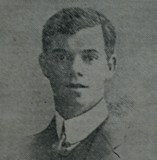
David Llewelyn Lewis, Boatswain (Bosun), Mercantile Marine. David was born in 1892, the son of Evan and Elizabeth Jane Lewis, of Dalston House, Borth. He served in the Mercantile Marine aboard the SS Heathpark. On 5 October 1918, Heathpark was torpedoed and sunk by the German submarine U-91 whilst in the Bay of Biscay. David was one of three Borth men killed aboard her that day. He was 26 years old, and is commemorated on the Tower Hill Memorial, London.
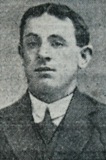
Desmond Maurice Macartney-Filgate, Second Lieutenant, Royal Air Force. Desmond was the son of Charles and Mary Macartney-Filgate, of Florence Place, Borth, and grandson of the late Townley Macartney-Filgate, of Lowtherstone, Balbriggan. He was commissioned into the Royal Flying Corps on 9 March 1918, and attached to the 42nd Training Squadron, Royal Flying Corps, where he trained as a pilot. Desmond was seriously injured in a training accident in May 1918, and died on 31 May 1918, aged just 18. He is buried at Wye (Ss. Mary and Martin) Churchyard, England.
Morgan Morgans, Sailor, Mercantile Marine. Morgan was born in 1889, the son of David and Mary Morgans, of Gogerddan House, Ynyslas, Borth. He served with the Mercantile Marine aboard the SS Penvearn. On 1 March 1918, Penvearn was 15 miles from South Stack, Anglesey when she was torpedoed and sunk by the German submarine UB-48. Morgan was 29 years old when he died that day, and he is commemorated on the Tower Hill Memorial, London.
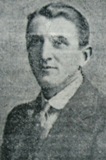
James Davies Williams, Private, 31899, 4th (Queen’s Own) Hussars. James was born at Borth in 1891, the son of David and Annie Williams. The family later moved to 12, Hodson Street, Wigan, where James was raised. James enlisted at Aberystwyth into the 4th (Queen’s Own) Hussars, which was attached to the 3rd Cavalry Brigade, 2nd Cavalry Division. James landed in France on 14 May 1915, joining the battalion after it had suffered heavy casualties in the Neuve Chapelle sector. The 2nd Cavalry Division didn’t see much action during the whole of 1916, but in 1917 saw extensive fighting at Arras, and at Cambrai later in the year. The Cavalry was caught up in heavy fighting during the German offensive on the Somme in March 1918, then at the Lys the following month, and James was wounded during this desperate time. He was evacuated to hospital at Boulogne, where he died of his wounds on 26 April 1918. James was 27 years old, and is buried at Boulogne Eastern Cemetery, France.
